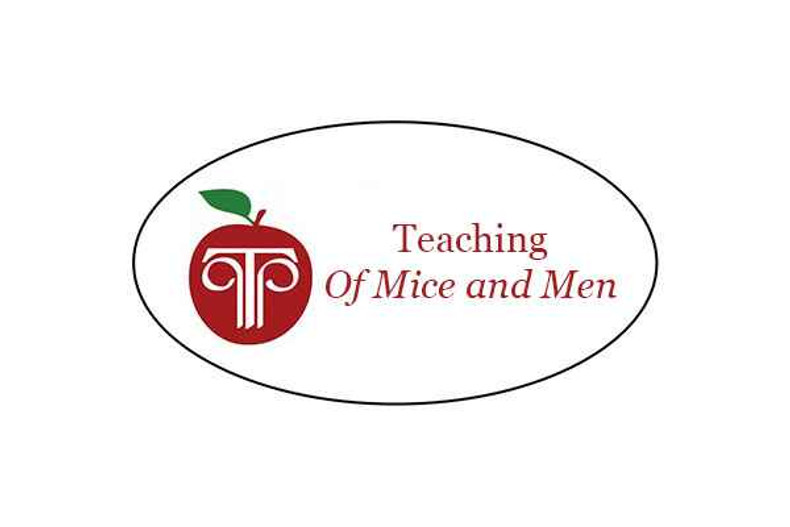Overview Commentary on Of Mice and Men
Of Mice and Men is a short novel--just a little over 100 pages--and the reading level isn't particularly difficult. However, because of the subject matter, it is most appropriate for high school juniors and seniors, who are old enough to understand the complexities of the book.
On the surface, Of Mice and Men is a simple story. Two pals (George and Lennie) who are ranch hands have left their former place of employment because of some kind of trouble. They're hired on at a new place and begin to work. They dream of one day having their own land and own animals to tend. As the story unfolds, we learn that George looks after Lennie, who is very strong but mentally challenged. The wife of the boss's son flirts with the men, including Lennie. One day Lenny innocently touches her. She thinks he's going to abuse her and panics, which causes him to panic. In his panic, accidentally kills her. In a somewhat shocking ending, George actually kills Lennie to protect his friend from the wrath of the boss's son and the punishment Lennie would inevitably have to face for killing the woman.
Understanding the deep relationships among the characters and ultimately the reason for George's killing of Lennie requires maturity.
Some Things Your Students Should Know About Of Mice and Men
Of Mice and Men is about the longing people have for two things: friendship and the achievement of one's own dreams. It is a dark novel in that, according to the events of the story, neither of these things is possible to acquire or keep.
Many of Steinbeck's works were written during and/or are about the time of the Great Depression in America. Your students should learn about that era and come to conclusions about how that affected Steinbeck's view of the world and his stories.
The animals in the story are important symbols. Lennie's mice and his puppy are innocents destroyed completely by accident. The discussion about putting down Candy's dog is the opposite; some feel the dog needs to be killed because it is old and useless. Killing the dog is a deliberate act. Lennie wants to tend rabbits on their future farm, and rabbits are traditionally associated with reproduction, life, springtime, hope. And, each of these animal symbols relates directly to the situations of the people in the story. Exploring these symbols and all the nuances of the ways they relate to the people in the story makes for great discussions.
This is a "character" book; a story in which character is the dominant element of fiction. The main characters are fully developed. The things the characters say and do, and the situations in which the characters play out their roles are what develops the themes of the story. Relationships (and/or lack thereof) between the characters are important. In some stories, the plot twists or the conflicts are dominant, but this is a story about people--their hopes and dreams, and the harsh realities of a largely predatory and uncaring world which makes their hopes and dreams impossible to achieve.
This is the world of mice and men. The main female character in many ways is an Eve, tempting and leading the men to immorality, evil, bad things. Even the minor character of the woman in Weed was the cause of George and Lennie's having to leave that place and move on. In the lonely man's world of ranch hands, hard work, and bunk houses, women are desired but shown as being nothing but trouble.
Innocents versus predators is one theme in the book worth discussion. Who are the innocents? Who are the predators who seek to put down others? Who is knowingly a predator? Who is a predator--the cause of death or undoing--by accident? When you explore the relationships and characters' traits and actions, sorting out traditional good guys from bad guys all becomes very complicated, expressed ultimately in George's killing of Lennie, which is central to the whole book.
A Brief Biography of John Steinbeck
STEINBECK, John (1902-68). Winner of the 1962 Nobel prize for literature, the American author John Steinbeck is best remembered for his novel The Grapes of Wrath. Steinbeck's story of a family of farm workers migrating from Oklahoma to California describes the hopelessness of the Great Depression era.
John Ernst Steinbeck was born on February 27, 1902, in Salinas, California. He took classes at Stanford University for several years but left without a degree. He worked as a laborer to support himself while he wrote. Steinbeck's first novel was published in 1929, but it was not until the publication of Tortilla Flat in 1935 that he attained critical and popular acclaim.
He followed this success with In Dubious Battle (1936) and Of Mice and Men (1937). The Grapes of Wrath (1939) earned for Steinbeck a Pulitzer prize. In these works Steinbeck's proletarian themes are expressed through his portrayal of the inarticulate, dispossessed laborers who populate his American landscape. Both Of Mice and Men and The Grapes of Wrath were made into motion pictures.
In 1943 Steinbeck traveled to North Africa and Italy as a war correspondent. Some of his later works include Cannery Row (1945), The Pearl (1947), East of Eden (1952), The Winter of Our Discontent (1961), and Travels with Charley (1962). He also wrote several motion-picture scripts, including adaptations of two of his shorter works-The Pearl and The Red Pony.
Steinbeck died in New York City on December 20, 1968.
---- Courtesy of Compton's Learning Company
Ideas for Discussions Related to Of Mice and Men
- If you were George, could/would you have killed Lennie?
- Defend or refute Steinbeck's portrayal of women in Of Mice and Men.
- Consider people's hopes and dreams. Why are they important in life? Do you agree or disagree with the idea that hopes and dreams are not attainable? Why?
Teaching Resources For Of Mice and Men
Common Core Approach To Teaching Literature

